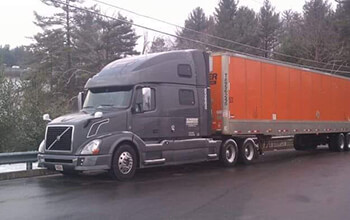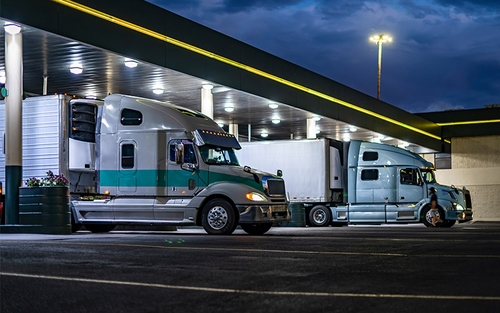How much is semi-truck insurance? Average costs and more
September 25, 2023

Estimated reading time: 4 minutes
Insurance is one of the many costs associated with being an owner-operator. If not properly understood and managed, it can quickly become a company’s biggest expense.
And while providing an exact answer to, ‘How much is semi-truck insurance?’ is impossible, this article can help you better understand what kind of insurance your trucking company may need, what factors affect your costs and what price range you can expect to pay.
What kind of insurance do you need for a semi-truck?
How you run your business impacts what kind of insurance you need for your semi-truck. As an owner-operator, you run your business one of two ways:
1. Operating under your own authority.
When operating under your own authority, you are primarily responsible for all insurance needs. As the owner-operator, you will typically be responsible for:
- Commercial auto liability insurance (includes uninsured/underinsured motorists).
Commercial general liability insurance.
Cargo liability insurance.
Workers’ compensation or occupational accident insurance.
Physical damage insurance (per equipment finance agreement).
2. Doing business with a motor carrier.
When doing business with a motor carrier and operating under its authority, the motor carrier will generally provide some of the necessary insurance to the owner-operator. As the owner-operator, you will typically be responsible for:
- Workers’ compensation or occupational accident insurance.
Physical damage insurance (per equipment finance agreement).
Non-trucking liability insurance (often referred to as “Bobtail” or “Unladen” insurance).

How much is semi-truck insurance?
Currently, the average semi-truck insurance cost per month for someone who does business with a motor carrier is about $300-$400 per truck, per month (or $3,600-5,000 per year).
Someone who operates under their own authority can expect to spend about $1,167-$1,833 per truck, per month on insurance (or $14,000-$22,000 per year).
Average cost breakdown of owner-operator truck insurance:
- Commercial auto liability insurance: $9,000-$15,000.
Commercial general liability insurance: $500-$800.
Cargo insurance: $400-$1,200.
Workers’ compensation: $3,000 - $5,000 (or occupational accident insurance: $1,600-$2,000).
Physical damage insurance: $1,500-$4,000.
Non-trucking liability insurance: $350-$480.
These figures are not quotes. Rates will be subject to each insured owner-operator. It's important to read your insurance policies carefully to understand exactly what coverage they provide.
What does each type of insurance cover?
At this point, you’re probably wondering why your trucking company needs all these types of coverage. Some types are required by federal or state regulations.
And while it may seem excessive, protecting yourself is absolutely necessary in case an unexpected event does occur. Only you can decide how much protection your business needs from those unexpected events.
Here is a breakdown of what each insurance type typically covers:
- Commercial auto liability insurance: Covers damage to other people and their property that is caused directly by your equipment.
Commercial general liability insurance: Protects your business from specific exposures (e.g., litigation) which may arise from damage caused by day-to-day operations.
Cargo insurance: Covers damages done to the goods you haul while they are in transit.
Workers’ compensation or occupational accident insurance: Covers medical, disability, death and dismemberment benefits for accidents that occur on the job.
Physical damage insurance: Protects your truck during unexpected events like weather, fire, theft and vandalism.
Non-trucking liability insurance: Covers property damage or bodily injury you inflict on another party when you are not operating under the authority of the motor carrier you do business with.
What impacts how much your semi-truck insurance costs?
While how you run your business impacts what kind of insurance your truck needs, there are many factors that impact how much each type of insurance will cost you.
These factors can include:
- Operational influencers: Such as where you conduct business, how far you travel and the type of commodities you haul.
Your experience: Such as how long your company has been in business and your years of experience as a CDL driver.
Your safety: Such as driving history (accidents and violations), compliance records and your company’s policies, procedures, safety equipment and technology.
Your equipment: Such as year, make, model and declared value of the equipment that is being operated.
Your financial record: Such as your credit history, payment terms and deductible responsibility.

How can you lower your semi-truck insurance costs?
There’s no secret formula to lowering your truck insurance cost; however, we have a few pointers you can consider:
1. Do your research.
When determining who to buy truck insurance from, don’t just settle on the first company you come across. Check around and see what each has to offer regarding:
- Discounts.
Special offers.
Rates.
Plus, you’ll want to ask about value-added products and services that will improve your overall safety and reduce your long-term costs.
2. Pay your insurance in one yearly lump sum.
Most insurance companies allow owner-operators to pay their truck insurance on a monthly or yearly basis. Paying for the entire year in one payment may feel like a big hit to your wallet at the time, but in the long run, you’ll most likely save money than if you paid each month.
3. Establish better habits.
Insurance rates increase for drivers who get into accidents, violate the law or are unorganized.
While you cannot change what happened in the past, you can actively work to do better in the future. Consider investing in:
- Additional safety training.
A document management system.
Equipment upgrades.
4. Consider doing business with a motor carrier.
Another way to decrease your insurance costs is to switch from operating under your own authority to doing business with a motor carrier.
Owner-operators who do business with a carrier, such as Schneider, can save 50-75% per year on their insurance costs compared to those who operate under their own authority.



